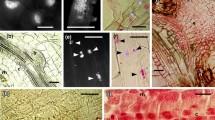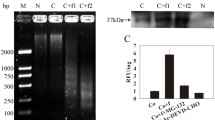Abstract
Detection of stereotypic hallmarks of apoptosis during cell death induced by menadione, including DNA laddering and the formation of apoptotic bodies, is reported. Comet assay and the TdT-mediated dUTP nick end labelling (TUNEL) procedure were also performed to detect DNA fragmentation. Inhibition of DNA fragmentation by Ac-Asp-Glu-Val-Asp-aldehyde (Ac-DEVD-CHO) and phenylmethylsulfosyl (PMSF) implicated the involvement of caspase-like proteases in menadione-induced apoptosis in plants. We further studied the cleavage of lamin-like proteins during apoptosis in menadione-treated tobacco protoplasts. In animals, it has been reported that the solubilization of nuclear lamina and lamin degradation occurs during apoptotic cell death. However, little is known about the fate of lamins in apoptotic plant cells. Our study provided evidence that lamin-like proteins degraded into 35-kDa fragments in tobacco protoplasts induced by menadione, and this preceded DNA fragmentation. The results thus indicated that proteolytic cleavage of nuclear lamins was also conserved in programmed cell death in plants.
Similar content being viewed by others
Author information
Authors and Affiliations
Corresponding author
Additional information
Received 16 November 1998; received after revision 21 December 1998; accepted 23 December 1998
Rights and permissions
About this article
Cite this article
Sun, YL., Zhu, HZ., Zhou, J. et al. Menadione-induced apoptosis and the degradation of lamin-like proteins in tobacco protoplasts. CMLS, Cell. Mol. Life Sci. 55, 310–316 (1999). https://doi.org/10.1007/s000180050293
Published:
Issue Date:
DOI: https://doi.org/10.1007/s000180050293




